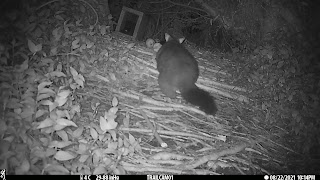While we are currently in a national lockdown we have limited sound lure testing in progress. We are collating the data and information as we continue to modify and test the viability of various units. This morning when checking a deployed camera there was a series of images that require explanation as they are quite striking.
Experimenting with the use of Sound Lures in New Zealand to increase the effectiveness of trapping.
Sunday 29 August 2021
Evidence of Possum Wrecking Deployment Site
Sunday 22 August 2021
Reviewing the Initial Unit after Twenty Months Deployment
Pictured Left is one of the initial units which was deployed outside in November 2019. This unit while it has undergone several basic revision is essentially the same and is still functioning, despite having being deployed outside constantly for an entire winter.
The solar panel was a $12.00 (5v/1.2w) purchase via Ali Express in October 2019. It has produced enough power to run the unit in regular circumstances although it can struggle without responsible exposure after two days - we replaced this unit and upgraded it to a $25.00 solar panel in 2020. There is some variation in the power from the larger solar panels, as a general rule we would expect around
The connections which were single wires have subsequently been replaced with speaker wire available from a local hobby stockist. We have seen animals chew these wires and claw at them but not particularly damage them. Neither elements of the unit have needed to be replaced for its existence. The speaker was replaced, we have currently upgraded as speakers working with the units as we have refined the design. These have suffered in the elements - the original 4w speakers that were part of the project were purchased online from Aliexpress for $2.00 each and were replaced by more durable speakers (that cost double the price). We have customised the baffle by 3D Printing,
The IP rated box which was purchased for a minimal amount ($20.00) has been excellent and there is minimal evidence of moisture entering the unit. With other units in the sequence we used desiccant to absorb moisture and we are now looking significantly at using MDF to absorb moisture and provide a platform on which to mount the breadboard and hold the battery in place.We are using with this unit the same basic program that has been present for two years, although we have already stated we could clearly use a significant increase in the number of sounds and the frequency etc.
The area where the unit is being deployed has undergone considerable rainfall including the river within a few metres of the camera/trap set up bursting its banks for the first time in seven years.







